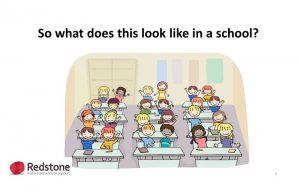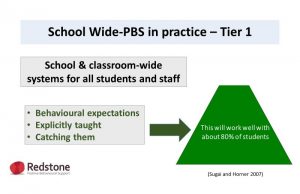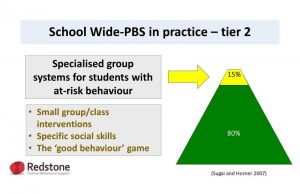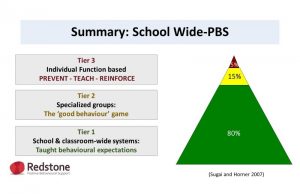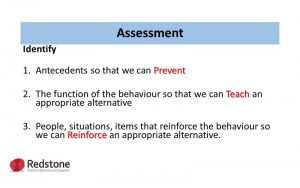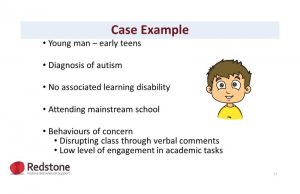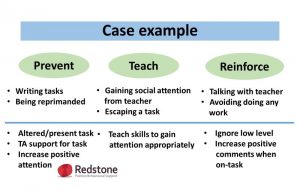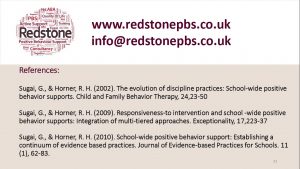The content in this post is from a short talk by Kate Strutt at the Autism Show in Manchester.It is a brief overview of some of the key elements of a school wide positive behaviour support. The aim is to provide some ideas and thoughts about how to improve behaviour across different schools and a brief introduction to this approach.
© Redstone PBS 2017
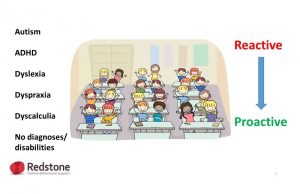 Within any school there are children with many different needs. We know that some children with autism will be more vulnerable to presenting with behaviours that challenge and children who have no disabilities or diagnoses may also present with such challenges. With many competing demands how are teachers going to manage this? One way is to take a reactive approach. In specialist school settings this usually includes to managing behaviours at early signs using de-escalation techniques. In non-specialist school settings, often sanctions are used.
Within any school there are children with many different needs. We know that some children with autism will be more vulnerable to presenting with behaviours that challenge and children who have no disabilities or diagnoses may also present with such challenges. With many competing demands how are teachers going to manage this? One way is to take a reactive approach. In specialist school settings this usually includes to managing behaviours at early signs using de-escalation techniques. In non-specialist school settings, often sanctions are used.
A key element of the PBS approach is to get strategies and interventions in place proactively, before there are any signs of behaviours that are challenging.
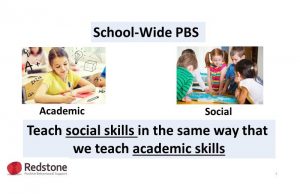 A further key element of PBS in schools is the approach to social behaviours.
A further key element of PBS in schools is the approach to social behaviours.
Regarding academic skills, we often start with easy examples and tasks, provide support and feedback about how to improve. However, the approach to social behaviour is often to try to punish or discourage inappropriate behaviour. The school wide PBS approach aims to teach pro social behaviours.
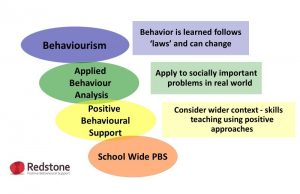 The foundation of school wide PBS is the scientific understanding of how behaviours work. Applied behaviour analysis (ABA) is the application of that science to socially important issues. PBS is a further application of ABA and school wide PBS is school specific application.
The foundation of school wide PBS is the scientific understanding of how behaviours work. Applied behaviour analysis (ABA) is the application of that science to socially important issues. PBS is a further application of ABA and school wide PBS is school specific application.
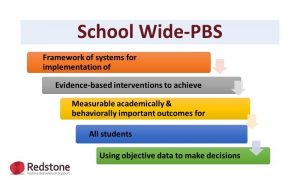 School wide PBS is not a specific approach, intervention or technique, but is framework for using evidenced based practice with a focus on both academic and social behaviours.
School wide PBS is not a specific approach, intervention or technique, but is framework for using evidenced based practice with a focus on both academic and social behaviours.
There is a growing evidence base for school wide PBS. In the US it is used across whole state schools systems. In the UK there is currently a focus on implementing within some specialist schools.
School wide PBS is a tiered approach to implementing interventions. There are three tiers which are described below.
Tier 1 includes systems which are applied cross all pupils and staff which works to reduce about 80% of behaviours that challenge. This includes agreeing
Behavioural Expectations
- 3-5 behavioural expectations, positively stated and easy to remember
- In other words, rather than telling students what not to do, the school will focus on the preferred behaviours.
Here are some examples from other schools:
Respect Yourself, Respect Others, and Respect Property, Be Safe, Be Responsible, Be Respectful, Respect Relationships and Respect Responsibilities
Label and Teaching Appropriate Behaviour Actions and Observe and Praise Appropriate Behaviour
Tier 1 will tackle a good proportion of behaviours it still leaves issues for a proportion of children
Tier 2 – This can resolve around 15% of remaining behavioural issues and includes small group work around specific social skills or class specific interventions such as the ”good behaviour game.
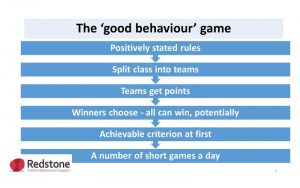 The game should be called something else in the class for obvious reasons! The class agree the rules such as staying in seat, using quiet voice. The class are split into a number of teams. Essentially all the groups can win if they all meet the criteria this is not a contest between group but against an agreed criteria. Set the criterion that is achievable, further games can include a criterion that is a little harder to reach and so on. Winners choose from things that are age relevant and appropriate for school setting, and are no cost. This can be choosing an activity, getting to sit in chosen place etc.
The game should be called something else in the class for obvious reasons! The class agree the rules such as staying in seat, using quiet voice. The class are split into a number of teams. Essentially all the groups can win if they all meet the criteria this is not a contest between group but against an agreed criteria. Set the criterion that is achievable, further games can include a criterion that is a little harder to reach and so on. Winners choose from things that are age relevant and appropriate for school setting, and are no cost. This can be choosing an activity, getting to sit in chosen place etc.
Studies have shown that use of this model results in decreased classroom disruptions (by 50–90%), a greater number of students fully engaged in learning (by 20–50%), decreased referrals and suspensions (by 30–60%), and more time for teaching and learning (by 25%). Longitudinal studies in the US have also shown that children who experienced the Good Behavior Game in elementary school were less likely to be involved in violent behaviors later in life and were less likely to use tobacco or other drugs later in life. Click here for key study.
So what about the remaining 5% of behavioural issues ?
Tier 3 – For a small number of children an individualised function based assessment and interventions is required. Below outlines what we mean by function based. For individualised approaches in schools Redstone uses the Prevent Teach Reinforce model of PBS and this is also detailed further below.
 All of our behaviour occurs for a reason and we call this the function of behaviour. The functions of behaviour are essentially to gain or avoid.
All of our behaviour occurs for a reason and we call this the function of behaviour. The functions of behaviour are essentially to gain or avoid.
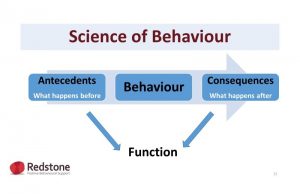 We work out the function of a behaviour by looking at what happens before the behaviour occurs and what happens after. What happens before helps to understand what might be motivating our behaviour, what happens after helps us to see what results the behaviour gains for us. Motivations and results are linked to whether we will do that behaviour again in the future.
We work out the function of a behaviour by looking at what happens before the behaviour occurs and what happens after. What happens before helps to understand what might be motivating our behaviour, what happens after helps us to see what results the behaviour gains for us. Motivations and results are linked to whether we will do that behaviour again in the future.
 The Prevent-Teach-Reinforce (PTR) model of PBS enables us to make an assessment at each of the three points above to identify what happens before the behaviour, what happens after and the function of the behaviour. It then guides us to put specific interventions in place in each of those three areas. A case example is discussed later.
The Prevent-Teach-Reinforce (PTR) model of PBS enables us to make an assessment at each of the three points above to identify what happens before the behaviour, what happens after and the function of the behaviour. It then guides us to put specific interventions in place in each of those three areas. A case example is discussed later.
Dunlap, Iovannone, Kincaid, Wilson, et al (2010). Prevent, Teach, Reinforce: The School based Model of Individualized Positive Behaviour Support. Brookes. Link for paper by same authors
Downloadable leaflet on Prevent Teach Reinforce for schools
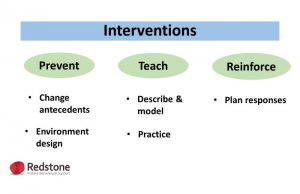 An intervention must be in place for all three areas of PTR.
An intervention must be in place for all three areas of PTR.
For Prevent, interventions focus on changing or adapting the conditions that occur before the behaviour
For Teach, interventions focus on the function of the behaviour and supporting the person to learn a new skill which meets that same function.
For Reinforce, interventions focus on those around the person and their responses both to behaviours that challenge and the new behaviour skills. This is especially important to avoid providing results which make the unwanted behaviour reoccur and not giving results for the new skill. Not giving the right results for the new skill will mean that it is not used risking the old behaviour returning.
The top section shows what we identified through the assessment process in each of the three areas of the PTR model.
The bottom section outlines what we put into place in each of the three areas. Increasing general positive comments for the teacher was a key element as a negative relationship had developed between the pupil and certain teachers. It was also important to increase positive teacher comments for even small amounts of on-task behaviour as this helped to shape the behaviour that we did want to see which was incompatible with being disruptive.
We hope you’ve fund this information useful and its provided you with some thoughts and ideas! Obviously the first two tiers may look different depending on the type of school and would need to be adapted for children who may not understand verbally stated rules. Similarly, in some schools the proportions of children requiring individualised assessments and interventions may be higher.
If you’re interested in finding out more about how you can implement the school wide PBS approach in your school click here.
Sign up for more information, training offers and new PBS blogs here
© Redstone PBS 2017
 Author- Kate Strutt Director of Redstone PBS and clinical psychologist with over 19 years’ experience of working in intellectual disability and autism services, both within statutory services and the independent sector. Kate is a member of the British Psychological Society and is registered with the Health and Care Professions Council. Bsc Psychology, D.Clin Psyc, PG Certificate Applied Behaviour Analysis.
Author- Kate Strutt Director of Redstone PBS and clinical psychologist with over 19 years’ experience of working in intellectual disability and autism services, both within statutory services and the independent sector. Kate is a member of the British Psychological Society and is registered with the Health and Care Professions Council. Bsc Psychology, D.Clin Psyc, PG Certificate Applied Behaviour Analysis.
Contact: kate.strutt@redstonepbs.co.uk



